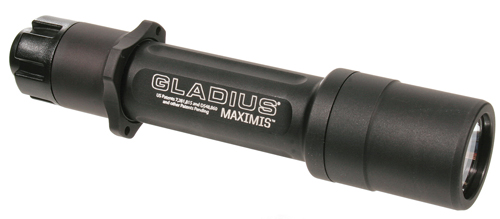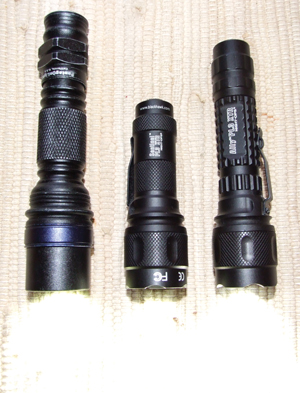
Blackhawk GladiusMaximis
Blackhawk
Blackhawk, the internationally-renowned purveyor of all thingstactical gear-related, provides a fine line of tactical (notpatrol) illumination tools/flashlights of the highest quality —even though it doesn’t make its own lights.
My first experience with Blackhawk lights was with the GladiusNight Ops, produced by Insight Technology. It was the firsttactical light I used that had a strobe feature. The main featureof the Gladius is the unique tailcap switching system, which hasbeen picked up by other companies. The system has five modes and isoperated by twisting it into the proper position, then activated bypushing the tailcap button. The modes are momentary on,constant-on, strobe, dimming, and lock-out. The light has six voltsof power.
The original Gladius is rated at about 65 lumens, and has beenupgraded to 120 lumens and marketed as the Maximis. The light iseasily operated and comes with a lanyard. I received a Maximis fortesting and comparison against the original Gladius. There is nodifference externally between the two lights other than the markingon the Maximis. The color scheme is the same (black as tested), asare the controls.
 PentagonLight’s 60-lumen X2 shownwith the Blackhawk Sentinal light and the 110-LumenAlly. |
One visible difference is that the central element of the LED onthe Maximis is about twice the size as the one on the Night Ops,but you have to look at the lights side by side. The realdifference, of course, is the light beam. The light heads and beamsare the same size but, at 120 lumens, the Maximis gives a muchwhiter light beam. It is sharper and has a tighter, better definedcentral portion, and a wider corona than the older model.
The tailcap functions are the same. The tailcap must be put on thelight when adding or changing batteries, and a pin in the tailcap must be aligned with a notch in the main body to operateproperly (otherwise you risk damaging the light). Blackhawk hasadded a notice to this effect on the main body under the cap. Whilethat part is marked better, it’s still hard for me to see the pininside the cap, as it is very small and sits high inside. It’d benice if there were alignment marks on the exterior of the light,but that really is a minor point.
The Gladius Night Ops, and now the Maximis, is my light of choicefor dynamic entry when using a pistol, with the lanyard looped ontomy left wrist and operated in strobe mode.
The Gladius Maximis is a very solid light and not a gimmick. It’sone of my top picks for a handheld tactical light. My onlycomplaint for pocket carry is the tailcap, which features fourprotrusions ostensibly designed to aid in holding the light whenusing odd techniques like the “syringe.” These protrusions make theGladius somewhat uncomfortable to carry in a pocket and are hard onfabric. The designers could consider a round grip area for use ofthe syringe technique, or eliminate it altogether. There are alsotwo lanyard attaching points for some reason. In spite of thesesmall annoyances, I highly recommend this light.
The Blackhawk Night-Ops line also has several traditional handheldswith the latest technology. I tested the Sentinel PL3 XTR. This isa latest generation LED lighting system, and is a compact yetpowerful light. Powered by a single lithium cell, this mighty miteproduces 65 lumens of white light with three volts of power.
Billed as the most powerful light of its size, the Sentinelfeatures the CREE LED, standard aircraft aluminum construction,momentary off-and-on tailcap switch (I love not having to twistanything), glass lens for clearer light over plastic, a pocket clipfor bezel-up carry (handy for a tactical vest, not as much forstandard the pocket carry), and a crenelated bezel. To put lumenpower in better perspective, the packaging says that this one-celllight has the equivalent light output of a standard 6 or 7-D cellflashlight — amazing.
While field-testing the Sentinel, my girlfriend and I arrived ather home late one night. Earlier in the day she had been deposed ina divorce case against her husband who had some questionablebusiness ties. I had just pulled into the driveway when another carpulled in right behind me. It was pitch black and we weren’texpecting anyone. I couldn’t see anything but the headlights of thevehicle, which appeared to be an SUV.
I quickly stepped from the truck, conscious that my gun wasstrapped on my ankle, drew the Sentinel from my pocket, and raisedit into an FBI hold (shining it into the driver’s side windshield)as I approached. I was able to see one white male behind the wheel.I asked, “Can I help you?” The startled driver said that he hadjust pulled in to tell me I had no brake or taillights.
He was just a good samaritan doing me a favor, but I didn’t knowthat when he pulled in. I felt the need to take the offensive anduse my light as my initial contact weapon, just like on a trafficstop. Previous Page
This article is an excerpt from Own the Night: Selection and Use ofTactical Lights and Laser Sights by Commander Scott Wagner.
